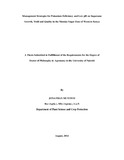| dc.description.abstract | Sugarcane production in Kenya has happened in monoculture systems over the last 60
years. In the last two decades serious concerns have emerged over yield decline by about
36% from a high of 110 t/ha in 1997 to a low of 69 t/ha in 2006 and only 51 t/ha in the
year 2013 (KSB, 2013). This was way below the world yield average of 64.4 t/ha (FAO,
2012). The yield decline in Kenya is strongly linked to soil degradation as reported in
other worldwide sugarcane production systems with long term monoculture; however,
there is paucity of information on actual causes of the low yields. This study, therefore,
sought to evaluate the impact of various management strategies for low pH and Kdeficiency
in the Mumias Sugar Zone of Western Kenya that accounts for 50-60% of
national sugar production. Three field experiments were carried out from 2009-2011 to
determine (i) the effects of nitrogen (N), potassium (K) and their interaction on
sugarcane yield and quality (experiment 1); (ii) the effects of phosphorus (P), agricultural
lime and their interaction, on sugarcane yield and quality (experiment 2); (iii) the effects
of agricultural lime, organic manures and selected fertilizers on sugarcane yield and
quality (experiment 3) and (iv) the agronomic efficiency and cost-effectiveness of the
various management options through economic evaluation. The design in experiments 1
and 2 was RCBD with a factorial arrangement of the treatments and three replications
while in experiment 3 was RCBD of eight treatments in three replications. Data was
collected on soil characteristics, rainfall received, sugarcane emergence, tillering, stalk
number, height and inter-node length, cane yield, sugar yield, juice quality and fibre
content, diseases and pests attack, Agronomic Efficiency (AE) and Economic evaluation.
Results from experiment 1 showed that application of K and N consistently increased
xxii
sugarcane tillering, stalk number, height and inter-node length. Cane and sugar yields per
ha generally increased particularly at rates of 60-120 kg/ha K2O and 46-92 kg/ha N.
Increase in sugar yield due to K application was attributed to improved juice quality (Pol
% cane). Agronomic efficiency (AE) was higher in plots supplied with K along with N .
Nitrogen and K2O application rates that produced optimum cane yields were: N =
46kg/ha and K2O = 60 kg/ha; however, economically profitable rates were N = 46-92
kg/ha and K2O at 60 kg/ha. Productivity gains did not offset costs when rates were higher
than 120 kg/ha of K2O and 138 kg/ha of N. The results imply that the inclusion of K in
the sugar cane fertilization regime at Mumias will be beneficial. An initial rate of 60kg/ha
K2O (2 bags of 50 kg muriate of potash is recommended on soils with K-deficiency.
There were strong indications that with K fertilization the current N recommendation of
120-150 kg N/ha could be reduced to only 80-120 kg/ha due to better N utilization from
the interaction with K. Results from experiment 2 showed that emergence, tillering, stalk
number, inter-node length, cane and sugar yields and Pol % cane increased significantly
(p< 0.05) with liming and P application. Although incremental levels of P led to
increased tillering, stalk population, cane, sugar yields and juice quality in the un-limed
treatment, there was no significant difference (p < 0.05) in the components at P levels
higher than 92 kg/ha P2O5. Agronomic efficiencies (kg sugarcane/kg nutrient) of P
application were greater in plots with supply of agricultural lime along with P at 46-92 kg
P2O5. Although higher value cost ratios (VCR) were recorded without liming, net returns
were higher in the limed treatment due to improved sugarcane yields. The results of this
study suggest that the inclusion of agricultural lime in the fertilizer regime at Mumias is
necessary and cost effective on soils with low pH. Where agricultural lime is applied the
xxiii
recommended P dose of 92 kg/ha P2O5 could be reduced to 46 kg/ha P2O5 with no adverse
effects on sugarcane yield. Results from experiment 3 showed that emergence, tillering,
stalk number, height, inter-node length, cane and sugar yields differed significantly (p <
0.05) among the treatments in all locations. Highest cane and sugar yields were recorded
in treatments where agricultural lime and compost were included. Sugarcane juice quality
was highest in the SSP + Urea treatment ranging from 13.58 - 14.43 % Pol and lowest in
the compost treatment ranging from 11.43- 13.37 % Pol. Smut incidence was notable in
the compost and control treatments. Agronomic efficiency was highest in treatments
where compost and agricultural lime were included, ranging from 90.3-481.5 kg
sugarcane/kg nutrient. Highest net returns and value cost ratios were also recorded in
treatments with compost and agricultural lime. Based on these results the inclusion of
agricultural lime and organic manures in the cane production systems at Mumias is
recommended. | en_US |

